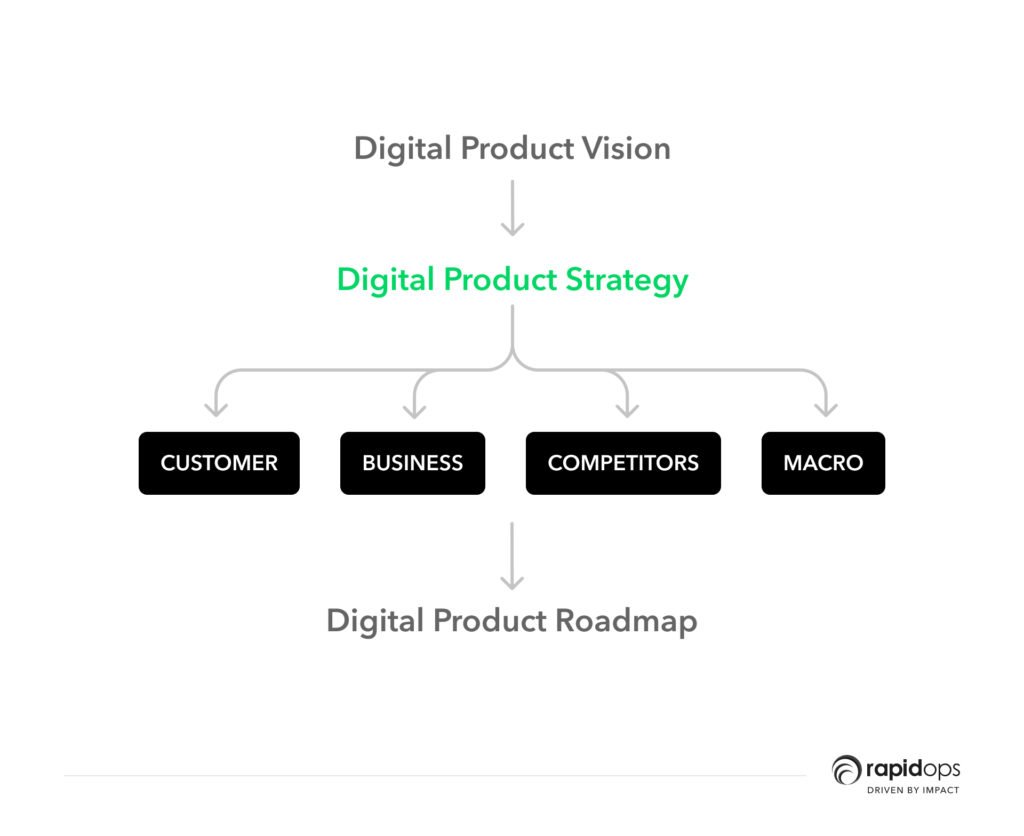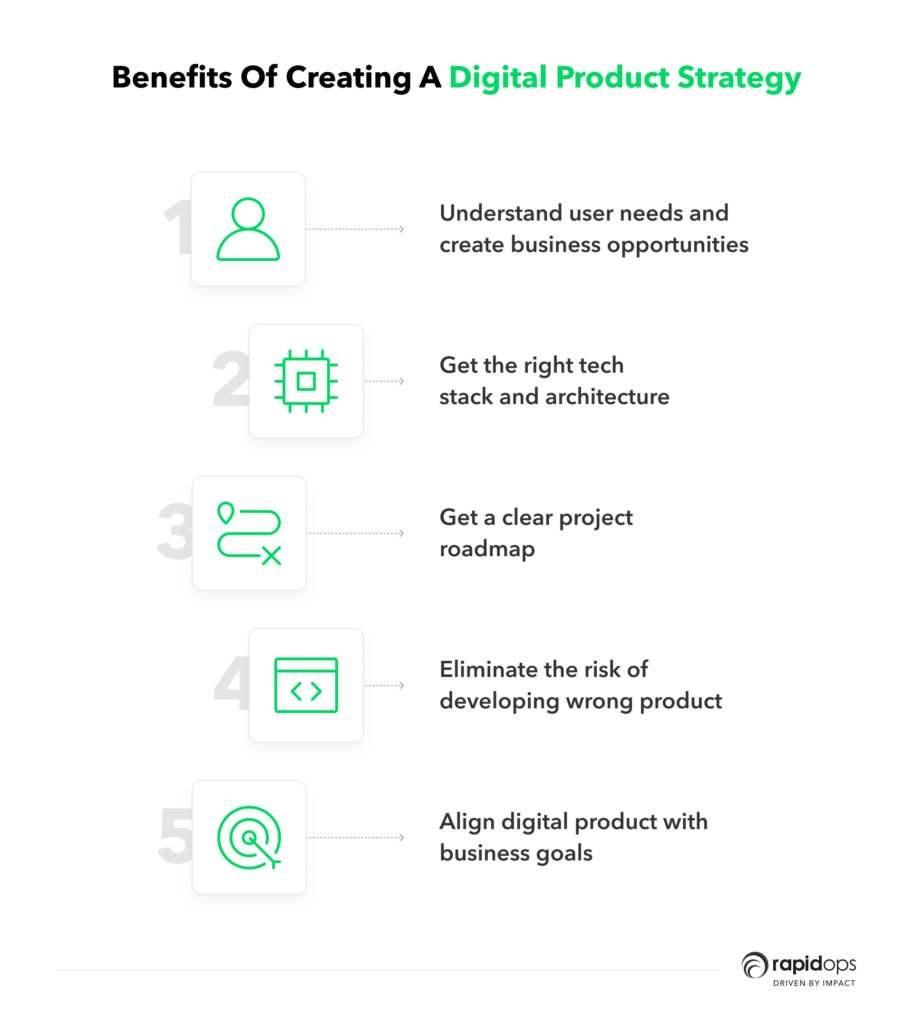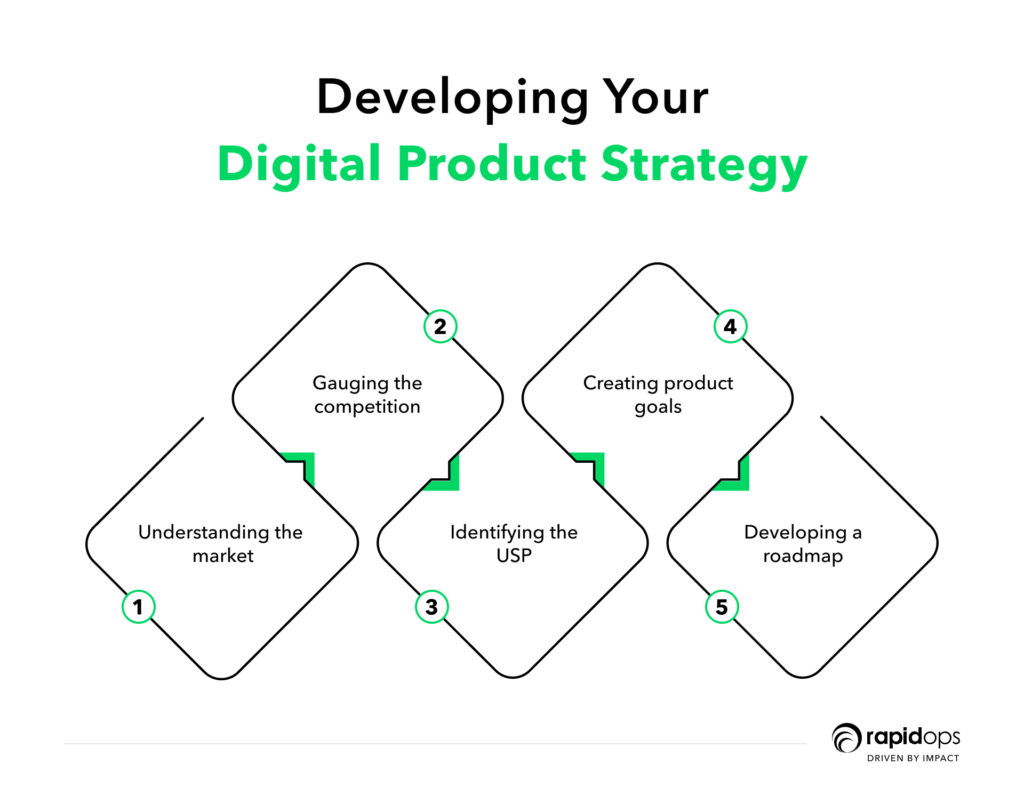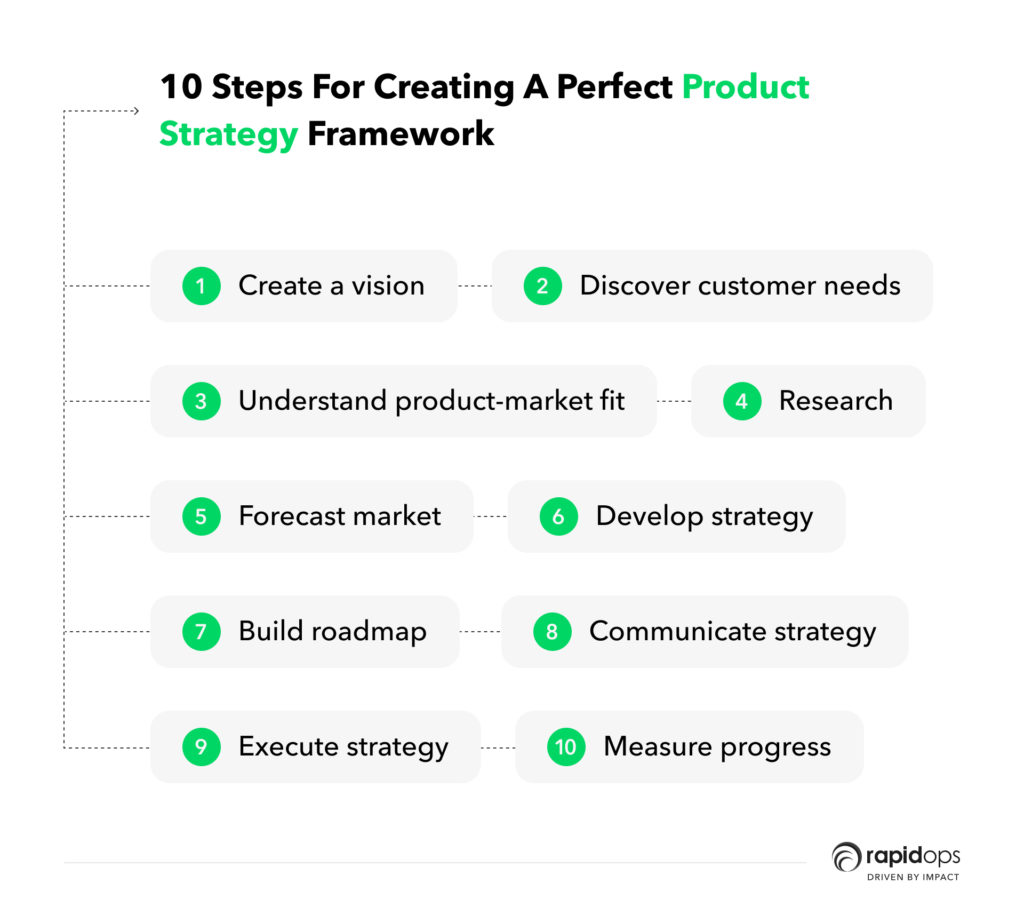- Strategy
- 12 min read
- April 2022
2023 Guide: Digital Product Strategy for Leaders | Rapidops
As digital products become more and more common, business leaders need to understand their digital product strategy. This guide provides an overview of the process of creating the design and some tips and tricks for envisioning your product's future.
What is a digital product strategy?

Product strategy is the process of discovering and gaining leverage in the competitive landscape for achieving the purpose of your product – Rapidops
Digital product strategy is creating a plan for how a digital product will be built, marketed, and sold. It considers the overall goals of the business and the needs of the target market.
It begins with understanding your target users and what they need or want from a digital product. You'll also need to understand your competition and how your product differs from theirs.
A digital product strategy is a plan that outlines
- how a digital product will be built,
- where and how it will be marketed.
A clear digital product strategy helps product teams understand the value their product will derive and how they will allow users to realize that value.
This includes understanding your customer's needs, gauging the competition, and analyzing your product's USP (unique selling point).
After the market analysis is complete, you can develop your digital product strategy. A strategic foundation is made up of five core elements:
- the product or service vision,
- an in-depth diagnosis of the challenges that need to be solved,
- the target outcomes for the business and the user,
- a coherent set of actions that need to be taken to overcome the challenge and move the business forward,
- and how you will measure that forward progress.
This will involve setting goals, target markets, and objectives. Once your digital product strategy is in place, only then can you begin to implement it by developing a product roadmap.
Creating a digital product strategy focuses on creating a path to help businesses develop a well-researched product for solving critical problems.
Is it worth creating a digital product strategy?
The short answer is yes! Having a digital product strategy is essential to succeed in the digital age. A digital product strategy provides direction and focuses on your digital product development efforts. It helps ensure that your product meets the needs of your target market and achieves your business goals.
Let’s see some of the most significant benefits of creating a digital product strategy:

1. Understand user needs and create business opportunities
Business leaders and executive teams can take a customer-centric approach by determining the needs of their target audience. Doing so will also help them create a product niche and create recurring opportunities.
2. Get the right tech stack and architecture
Choosing to invest in the right technology stack enables business leaders to ensure a lasting performance for their products and also its security.
3. Get a clear project roadmap
Executive teams will have a clear understanding of the objectives and initiatives needed for the project. It will also allow your team to establish the timeline that will not only optimize the workflow but also streamline the resource requirements.
4. Eliminate the risk of developing wrong product
A clearly outlined business goal for the product and the customer preference allows your team to reduce the chances of building the wrong product.
5. Align digital product with business goals
With a well-defined digital product strategy, businesses can focus on achieving their businesses goals with the product they build.
Companies are constantly reinventing themselves, or at least are trying ways to reinvent their offerings in response to the continuous digital disruptions occurring in their respective industry verticals.
Creating a digital product cannot be done in a hurry, no matter how you intend to execute it.
You'll need a strategy that
- starts at the top of the business
- works its way down to make informed decisions for product development
- helps your product stay ahead in the market.
To achieve product success, the product teams must balance company goals with user demands while also considering the required technology and end-user product usage.
How to get started with a digital product strategy?
A digital product strategy needs to be clear and concise. It should answer the following questions:
- What is the digital product?
- Who is it for?
- How will it achieve the company's goals?
There are a few key steps you can take to get started with your digital product strategy:
- Define your target audience
- Research your competition
- Analyze your unique selling points
- Set your goals and objectives
- Develop a product roadmap
With a digital product strategy in place, you'll be able to better focus your efforts on creating a product that meets the needs of your target audience while also achieving your business goals.
Creating a digital product strategy can seem daunting, but it doesn't have to be.
By following the steps outlined below, you'll be well on your way to developing the same to help your business compete and succeed in this digital age.
Let's get you started!
Developing your digital product strategy
We will turn this section into a workbook exercise, sort of, to help you understand the art of developing the digital product strategy.

1. Understand the target market
The first step in developing your digital product strategy is understanding your target market.
- Who are your potential customers?
- What needs do they have that your product can address?
- What are their buying habits?
Answering these questions will help you better understand who you should be targeting with your digital product.
2. Gauge the competition
Once you've identified your target market, it's time to research your competition.
- What digital products are they offering?
- How do their products address the needs of your target market?
- What are their strengths and weaknesses?
Competitor analysis will help you understand what you're up against and give you ideas for ways to differentiate your product.
3. The unique selling point
The next step is to analyze your unique selling points.
- What makes your digital product different from the competition?
- What features and benefits can you offer that appeal to your target market?
Answering these questions will help you develop a digital product strategy tailored to your unique strengths.
4. Create your product goals
Now that you understand your target market, competition, and unique selling points, it's time to set some goals and objectives.
- What do you want your digital product to achieve?
- How will you measure success?
Setting clear goals and objectives will help you stay focused on what's important and ensure your digital product strategy is aligned with your business goals.
5. Developing your roadmap
A digital product roadmap is a detailed plan that outlines the steps you'll take to achieve your digital product goals.
Your roadmap should include
- Timeline
- Milestones
- Deliverables
It should also identify who is responsible for which task and when it needs to be completed.
Creating a digital product roadmap will help ensure that your digital product strategy stays on track and meets your business goals.
What is a digital product roadmap?
A product roadmap is a tool for describing a product's vision, direction, priorities, and progress.
We may also characterize it as a tool for developing an organization's product features.
The time frame for producing the plan varies depending on the functional and feature demands.
What are the most important objectives of a product roadmap for digital products?
- Visualize the product goals and plans
- Make a to-do list for the coming month or years, and then rank them in order of importance
- Communicate the company's entire product strategy
- Getting stakeholders on the same page
Most common digital product strategy frameworks
There are different digital product strategy frameworks that companies can use to help them develop a clear and actionable digital product strategy. However, before selecting a framework, it's essential to understand the company's specific needs and objectives.
Once you understand your company's overall goals, you can then start to look at different digital product strategy frameworks and see which one would be the best fit. Some of the most popular digital product strategy frameworks include:
1. Lean startup methodology
This framework focuses on helping startups rapidly validate and iterate on their product ideas.
2. Design thinking
This framework helps businesses take a user-centric approach to product development.
3. Agile methodology
This framework allows businesses to iterate and deliver digital products quickly and efficiently.
4. The business model canvas
This framework helps businesses map out their business model and understand how their digital product will create value for their customers.
How to develop a digital product strategy framework?
No matter which digital product strategy framework you choose, the most important thing is that it fits your company's specific needs and objectives. Once you have a framework in place, you can easily develop your digital product strategy.
Ten steps for creating a perfect product strategy framework
This section will explain the steps followed by business leaders to develop their product strategy using a detailed framework.

Step 1: Create a bold product vision
As we've stated, your strategy should be a natural consequence of your product's goal or vision. So, before you can start writing out the strategy, you'll first need to establish your product vision:
- what you expect it will do for your user?
- will it add value to your target market?
- is it going to transform the world?
Be audacious; aim high and expand.
In short, have a giant objective.
Step 2: Discover customer needs and track their evolution
You may have a clear concept for your product before knowing your user persona well. However, to develop an effective product strategy, you'll need to understand your market
- what your clients require,
- what problems they confront,
- what are they willing to pay to fix it.
So now it's time to get to know these individuals better. Conduct some market research. Interview your user personas. Make a complete profile on them and see whether your product might help them solve any of their problems.
Step 3: Understand the product-market fit in the value chain
Your product won't exist in a vacuum. It will be part of your consumers' lives in general. You'll need to comprehend your user's entire life environment to see how your product fits in and whether or not they may run into any difficulties utilizing it—regardless of their intentions.
Netflix is a good illustration of this. The business diverted its business from delivering DVD rentals by mail to an internet streaming service (popularly known today as OTT platforms). But first, Netflix had to make sure that its new business model would function logistically, technologically, and financially for its clients and partners.
Questions the company would’ve had to answer before making this transition included:
Q1. Will the typical household have enough bandwidth to stream movies and television shows?
Ans. If so, the product might not work.
Q2. Will bandwidth continue to be priced based on the amount of data used, or will it switch to a flat monthly fee?
Ans. If that's the case, internet service providers (ISPs) will bill as per bandwidth, and the product might not work.
Q3. Some ISPs, who utilize a lot of our bandwidth, may block our material to protect their profits.
Ans. In such a scenario, the product will fail.
Step 4: Research similar growth patterns and cycles in other markets
You don't need to start from scratch to develop a product strategy. If you're attempting an innovation, see whether you can discover a successful product in another market and mimic its approach.
- What steps did the firm take to publicize its revolutionary concept?
- What went into their go-to-market plan?
- Is it possible for you to borrow elements from this other firm's strategy to create your product strategy?
- Could you come up with any other business tales of failure in that market?
- What methods did they utilize that you'd want to avoid in your plan?
Step 5: Forecast your markets change and prepare for it
You'll be able to appreciate how things might develop more clearly if you compare similar trends and patterns in other sectors. If you've gotten to know your user personas, you might be able to make educated predictions about where they'll take their markets or new tools and procedures they'll adopt soon.
Based on this information, you'll want to form educated guesses about future changes so that you may construct your plan accordingly.
Step 6: Develop the digital product strategy’s KPIs
You should aim to establish measurable KPIs while creating your plan rather than backfilling them afterward. This will provide you with quantifiable methods to see whether or not your product strategy is based on sound assumptions.
It allows your team to correct course more quickly if you find out early in the process that your first assumptions were incorrect. It also saves valuable time by preventing you from going down the wrong road while developing your product.
Step 7: Build the product roadmap
A product strategy should always be linked to product roadmap. Every theme, epic, and other product initiative that your team is considering should get a spot on the roadmap. Especially if they support the company's product strategy goal.
With this in mind, your roadmap should emerge naturally from the product strategy you just established.
Note: It becomes significantly important to include your strategic reasoning on the roadmap itself.
Step 8: Communicate your strategy
Once you've completed your product roadmap, you're ready to share your product strategy with all essential stakeholders. Your strategy should be conveyed through your roadmap; a vehicle for presenting high-level ideas and objectives—your "why."
- Spread the news about your plan to the internal team and the stakeholders.
- Don’t just discuss strategy; talk about the ambition behind the strategy.
- Remind your cross-functional team about the broad mission.
- Announce the particular strategy you've set out to get there.
Bonus tip:
A strategic explanation should support every significant theme or epic in your roadmap.
The roadmap should explain why adding certain features take priority supported by a brief strategic explanation, relevant datasets, etc.
Step 9: Begin executing your strategy
Now it's time for your team to turn the strategic phases into actionable tasks.
This might include enlisting the services of your UX staff to come up with mockups and your developers to develop functional prototypes of the product.
To assess your users' interests, ideas, and other feedback, offer a sneak peek of what the product will ultimately perform. This data will help you determine whether or not to continue to the following stage.
Step 10: Measure your progress and course-correct along the way
The more grounded your product strategy is in actual data, the greater your chances of success in the market.
With that in mind, you'll want to make your product strategy a two-way conversation between your team and your users.
At every stage of the product strategy framework, compare your current approach to the input you're getting from users. If your product is connecting with prospective clients, keep going.
Take this hint of feature addition or roadmap prioritization based on user feedback and find a new way to fulfill your product's goal.
Concluding thought: A solid digital strategy must always be your go-to for building the best digital business
Companies that build a robust digital product strategy can seamlessly focus on creating new products or services and generate significant value. Let’s give you a quick brief about developing the perfect digital product strategy.
A digital product strategy is essential for business leaders because it
- helps them gain a competitive advantage
- enables them to tap into the latest and relevant technology
- allows them to develop an innovative and user-friendly solution
- helps them create significant momentum for their product in the industry vertical
Companies that build a robust digital product strategy can seamlessly focus on creating new products or services and generate significant value.
Rapidops popularly leverages its expertise in technology, market research, customer experiences, and data analytics and helps global businesses develop disruptive digital product strategies for their revenue-critical digital opportunities. Tap into our team capabilities to bring your latest product ideas to life and create a scalable business.




